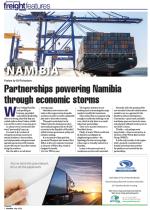Investment in a new deep-sea container terminal by the Namibian Ports Authority (Namport) is attracting a new class of larger container vessels.Many are calling on the port for the first time, with more than four maiden calls in May alone.
“Shipping companies have recognised that we are now offering a better service than many other ports in the region following the opening of the new container terminal,” Namport commercial executive Tino !Hanabeb told Freight News.Productivity has reached 59 moves an hour, with an average of 30 moves an hour – which reduces the time spent idle in port.
“Shipping lines are showing increased confidence in the port of Walvis Bay as we continue to position ourselves as Africa’s express hub to international markets. “A quicker link has been opened up from Europe as the preferred port of choice due to our improved efficiencies along the quayside and landside as Namport moved one million tons of cargo in the previous financial year across our transport corridors,” he said.Speaking in May during a ceremony to welcome the 8 4 5 0 -T E U Maersk Sheerness, – at the time the largest container vessel to dock in Walvis Bay, Namport acting CEO Kavin Harry said “the arrival of this vessel is of great significance, not only to the ports authority but to the entire country as this is not only consistent with our values and drive to become Africa's Number 1 port authority but also places Namibia in a more competitive position as it can now accommodate bigger vessels”. !Hanabeb said Namport was supporting hauliers operating on the corridors between Walvis Bay and neighbouring states by attracting bulk cargo such as sulphur.
This provides truckers with a back load after off loading copper in Walvis Bay.The objective was to lower the cost of using Walvis Bay as a gateway by doubling volumes to provide greater efficiencies for both shipping companies and hauliers, he said.Larger volumes will also create opportunities for warehouse operators.“We need more storage facilities in Walvis Bay for bulk shipments of 10 000 tons and more,” he said.

